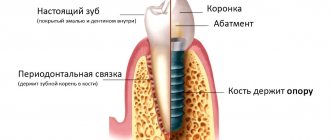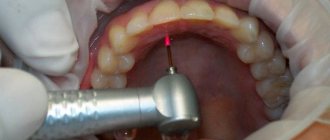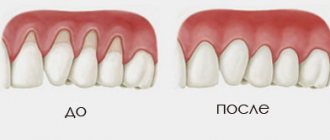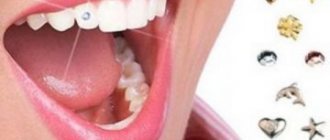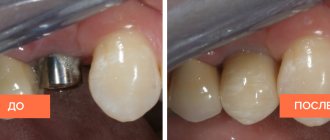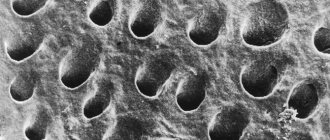In what cases are veneers placed, and who can do it?
Microprosthetic surgery is suitable for people over 18-20 – those whose teeth are already fully formed.
Accordingly, it is better for children and adolescents to wait. To undergo the procedure, a person must be healthy. Caries and other oral diseases must first be cured.
A suitable surface for fixing the pads is also important. If the incisor has been torn out, an implant is first placed in its place and a plate is fixed on it.
Pros and cons of veneers
Their advantages are as follows:
- They give results immediately - a snow-white smile will appear either in 1 visit or in 1-2 weeks. They do not need to be worn for years (like braces) to see visual improvements.
- They serve for quite a long time - from 5 to 20 years or even more.
- They look natural – indistinguishable from natural incisors and premolars.
- Easy to clean - you can use the same brush and paste as before.
- Inexpensive - much cheaper in price than other aesthetic solutions.
But there are also disadvantages, and these are:
- Impossibility of repair - if a chip, crack or other damage occurs, the lining will have to be replaced.
- The operation is irreversible - it is accompanied by the removal of enamel, so in the future it will no longer be possible to walk without a plate.
- Changes in eating habits - with such microprostheses, you can no longer eat solid foods (for example, nuts) or drink drinks that have a coloring effect.
Varieties
Onlays can be made of composite material or medical porcelain and zirconium. Porcelain products are more durable, but more expensive. Composite structures will last from three to five years, then they should be replaced with new ones. The advantages of composite veneers include price and ease of removal/installation. Componeers (composite plates) require more careful care and regular visits to the dentist to coat the surface with a special varnish.
The most reliable are zirconium linings; they can last more than twenty years. However, they do not look natural; this is noticeable to the naked eye. The artificiality of zirconium overlays is explained by the lack of light conductivity. Another disadvantage is the need for strong grinding of the enamel before installing them.
However, the biggest disadvantage of installing overlays made of any material is the loss of part of the enamel layer.
Lumineers
These overlays are called Hollywood and differ from ordinary veneers in their thinness. They are made from transparent porcelain and attached using a special adhesive.
Lumineers are highly durable and can last up to twenty years with proper care. Do not stain when eaten. However, Lumineers are not suitable for everyone. Lumineers are so transparent that they cannot mask stains or yellowness of the enamel layer.
There is another significant drawback of lumineers - when removing the plates, the enamel coating is inevitably destroyed. This is due to the peculiarity of the cementing composition on which the linings are attached: it is too strong.
Removable veneers perfect smile
This prosthesis imitates the gums and upper teeth. Used in emergency cases when a beautiful smile is needed. This is an invention of American orthodontists. The prosthesis provides a snow-white smile without preliminary grinding of the enamel and a visit to the dentist’s office.
How to use removable perfect smile veneers? It's very easy to do. Before the first fitting, the prosthesis should be placed in a glass of boiling water for several minutes so that the material becomes pliable. Then the denture is removed and applied to the upper teeth, holding it with your hand for 1-2 minutes. During this time, the material of the product will take its shape and remember its location. For subsequent uses, do not place the prosthesis in boiling water.
How often can you wear a perfect smile? The prosthesis is worn any time a charming smile is needed. How long can I wear a prosthesis? You can wear your perfect smile all day long, but before going to bed you need to remove it and wash it. Wash the denture with plain water and periodically clean it with mouthwash.
Ultraneers
Ultraneers are made from pressed ceramic chips. The advantages of onlays include quick adaptation, since the patient practically does not feel the foreign body in the mouth. The products look natural and are indistinguishable from real teeth. Lumineers are manufactured in the USA, so the cost of installation is always very high. Ultraneers are three times cheaper, since they are produced in Russia.
However, installation of ultraneers sometimes requires grinding of the enamel. The quality of ultraneers is inferior to lumineers in many respects, but they are cheaper. Ultraneers are also an alternative to aggressive whitening, as they protect the enamel from thinning.
Ultraneers are installed in two visits to the orthodontist’s office: during the first visit, an impression of the jaw is made, and on the second, onlays are installed. Ultraneers are easily removable and can be replaced with ceramic or zirconium veneers.
Indications and contraindications
Your doctor may recommend this option if:
- the top and/or bottom row is uneven;
- the enamel has darkened and/or cracked;
- irregularly shaped incisors;
- There are gaps between the teeth.
But the defects should still be minor.
The orthodontist will have to refuse the procedure if:
- most of the problem surface is sealed and/or destroyed;
- there is an incorrect bite;
- there is abrasion (starting from the second degree);
- have gum disease;
- the patient suffers from bruxism.
Each situation is considered individually.
What you need to know before installation
You've already read how dental veneers are made step by step, and you've also looked at photos of finished smiles. Are you making up your mind? Please note the following points:
- The operation is completely safe if the preparatory procedures are carried out correctly.
- There is no upper age limit.
- Grinding is mandatory - some layer of the natural coating will definitely be removed, from 0.5 to 0.7 mm.
- The condition of the cutter under the plate does not deteriorate (if it is tightly fitted).
- The pad is not removable, but it can be chipped and any damage requires replacement.
- Microprostheses last the longest if you maintain oral hygiene and give up bad habits.
- Biting food after they have been secured should be done carefully; it is better to avoid gnawing hard objects.
Is there any way to install without damaging the enamel?
Not yet, and don’t believe those who promise otherwise. But don’t be upset, turning is necessary and in some ways even useful, because it prevents the plates from layering, clinging to each other, making the jaw heavier, and inflaming the gums.
Features of the glue used
It is applied to the inside of the lining. To ensure better adhesion, the surface of the cutter is degreased and also covered with an etching gel for 3 minutes, but to protect it from bacteria. At the end of this time, the area of exposure is dried and illuminated with a lamp. Excess materials are then removed and transition areas are polished.
Benefits stated by manufacturers
If you go to numerous sites offering to purchase removable veneers online, you will see here and there photographs of people that are ideal from an aesthetic point of view, their teeth before and their transformed smiles after installing the onlays - with a beautiful enamel color, smooth, without cracks, stains or chips , hiding diastemas and even partially missing teeth. Such pictures naturally motivate people to buy. But not only them. Among other things, other advantages are positioned:
- monolithic design, thanks to which one overlay will be able to “hide” imperfections on all front teeth at once,
- universal size: it is assumed that they will fit any jaw and will hold well,
- low cost: from 500 rubles for a complete “transformation” of a smile,
- the possibility of not grinding down the enamel for such overlays, as well as the absence of the need to go through a “long” path of preparation for classical prosthetics, as is required in dentistry,
- can be worn for as many hours a day as needed,
- unlimited service life.
Lumineers: indications and installation
They are ultra-thin, they are chosen for the most minor damage:
- chips that do not affect bone tissue;
- fluorosis, darkening, spots, yellowness;
- staining of fillings;
- thinning of the coating, erosion;
- gaps between the incisors, their underdevelopment.
Their price is slightly more expensive than regular records, because they are made using more complex technology. But they hardly need modification (only in 1.5% of situations). It is enough to prepare a 3D model, make 0.5 mm thick overlays on it and place them on glue, after etching the enamel. The procedure is not painful - so much so that, as a rule, it does not require anesthesia.
Comments
I also fell for this trick. In fact, I purchased an expensive, useless trinket, but in my heart I felt like I had been deceived. Afterwards I tried to write a review, but I was blacklisted and blocked. Recently, a friend told me about Lumineers, supposedly they are from the USA and are great at hiding smile imperfections. What if there is a guarantee that this is also not a scam?
Irina (12/02/2021 at 10:19 am) Reply to comment
- Real lumineers are the original thinnest Cerinate or DUO-PCH overlays made in the USA. They really make a smile perfect or one might even say Hollywood. These are very high-quality products, created from casts of the patient’s jaws, and their actual service life can reach 20 years or more. But their installation should only be carried out by certified dentists who have the appropriate training and license. However, in practice, some clinics offer their patients “Lumineers” that are not related to the original. To avoid running into a fake, read in detail about Lumineers in our article on the website.
Editorial staff of the portal UltraSmile.ru (04.12.2021 at 19:20) Reply to comment
Write your comment Cancel reply
Features of fixing microprostheses from different materials
When discussing how you can correctly place veneers on your teeth at the dentist, you need to take into account that the fixation depends on their type.
- Ceramic should be formed in layers, processing after each pass; at the end - firing to acquire strength.
- Zirconium must be turned on an ultra-precision milling machine according to a cast and only in laboratory conditions.
- Porcelain ones need to be made according to a 3D model, very carefully, taking into account the fragility of a single plate.
All these nuances should be discussed with the doctor at the stage of the initial examination, even before the treatment plan is approved, in order to choose the truly optimal type and material of the overlays.
Bottom line
Perfect smile veneers are an imitation of the upper row of teeth along with the gums, thanks to which you can not be afraid to smile openly and joke. The perfect smile removable denture does not require a visit to the orthodontist or preliminary teeth grinding. To get a snow-white smile, you just need to put the denture on the upper jaw and hold it lightly until it takes the anatomical shape of your teeth. However, the perfect smile has a drawback: the lack of imitation of the lower jaw.
To correct small defects in the dentition, you can purchase lumineers: their installation does not require grinding of the enamel. If there are significant defects in the dentition, lumineers will not help, as they are made of completely transparent material. To correct large defects, ceramic onlays or plates made of composite material are required.
Sources used:
- The National Center for Biotechnology Information (USA)
- Proffitt U.R., Modern orthodontics (3rd edition), MEDpress-inform, 2015, 560 p.
- “Orthopedic treatment with fixed prostheses” (Rozenstiel S.F.)
Pain after grinding, eating habits
You can watch how veneers are chosen and how they are installed, but the video still won’t tell you about the feeling of discomfort that arises between preparation and fixation of the plates on a permanent basis.
The patient should be prepared that the incisors under the temporary onlays will ache within 4-5 days. During this period, it is better not to eat or drink anything cold or hot, and even rinsing with warm water is recommended. If it gets really tight, it’s acceptable to take a painkiller, but this is usually rare.
But severe and unremitting pain is not the norm at all, but a sign that the operation was carried out with errors, and a reason to immediately contact an orthodontist.
Snap-On Smile (“Snap-on Smile”) from the American company DenMat
The DenMat company is very scrupulous about the quality of its products.
These are created from impressions of the patient’s jaws directly in the manufacturer’s laboratory (USA), then sent to the treating dentist. The wait takes approximately 3-4 weeks. Snap-On Smile[1] are suitable for the comprehensive transformation of defective and even partially missing teeth (1-2 pieces). They are created from a light, plastic, but at the same time quite durable material - acetyl crystallized resin. They may consist of 4-6 artificial caps, or they may consist of 10-12.
Doctors note that these are indeed quite highly aesthetic overlays that look quite natural due to their compliance with the individual parameters of the patient. They are made of hypoallergenic materials, comfortable to use, adhere well to tissues and do not fall out of the mouth.
Although this is a temporary option that does not have good functionality, it is the best and safest alternative to removable veneers, which are offered for purchase on dubious portals on the Internet that have nothing to do with medicine. In addition, before their manufacture and installation, the patient undergoes oral sanitation, which includes the elimination of all existing dental problems that are harmful to health. Also, at the preparation stage, the doctor excludes contraindications, for example, teeth acting as support for the structure should not be damaged or mobile.
Notice
: Undefined variable: post_id in
/home/c/ch75405/public_html/wp-content/themes/UltraSmile/single-item.php
on line
45 Notice
: Undefined variable: full in
/home/c/ch75405/public_html/wp-content /themes/UltraSmile/single-item.php
on line
46
Rate this article:
( 1 ratings, average: 5.00 out of 5)
prosthetics, dental restoration
[1] According to the manufacturer’s official website: denmat.com
How to care for microprostheses
- Clean the oral cavity more thoroughly - without changing the toothpaste (if it does not contain abrasive particles), but three times a day and with a soft brush, as well as floss and irrigator - immediately after meals. Plus, go to the clinic every 3 months for polishing.
- Adjust your diet - be attentive to coloring foods (berries, beets, tea, coffee, wine), do not bite with incisors protected by plates, and chew with molars.
- Stop smoking so that the linings do not turn yellow and the gums do not become inflamed.
Care
Ceramic veneers require the same care as natural teeth. To preserve their aesthetics and extend their service life, it is recommended:
- reduce the consumption of foods with dyes (the linings will not change color, but the fixing cement may);
- wear a plastic mouthguard for bruxism - pathological grinding of teeth;
- do not subject teeth with veneers to increased stress (do not bite ice, do not open bottles, do not bite nails and hair ends, do not shell seeds);
- Do not miss dental checkups (once every six months).
